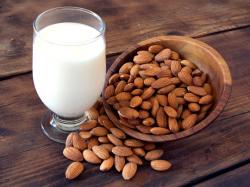Soy Milk Fades As Americans Opt For Drinkable Almonds
August 22, 2013 | 2 min to read

Non-dairy alternatives to good old-fashioned cow milk are spilling out into the mainstream, beyond the customary place in the fridges of America’s lactose-intolerant and vegan consumers. Sure, many still scowl at the taste of any milk that isn’t bovine in origin, but alternatives made from plants have grown to over $1 billion in annual retail sales in the U.S. For instance, at WhiteWave Foods (WWAV), the company behind leading soy milk brand Silk, sales increased 12 percent last quarter. And while the company got its start with tofu in 1977, since March a majority of its alterna-milk sales have been coming from another source: almonds. Sales of its newer almond-milk products grew by more than 50 percent last quarter.
Retail sales of dairy alternatives made from almonds, rice, and coconut milk in the U.S. are now nearly $1.4 billion, estimates Marketresearch.com, and are expected to reach $1.7 billion by 2016.
Something is clearly dampening enthusiasm for drinkable soy. WhiteWave claims that across the plant-milk industry, soy now represents just 35 percent of sales; almond milk, by contrast, has surged to more than 55 percent of the market. Research firm Euromonitor International expects U.S. retail sales of soy milk to fall a further 11 percent this year.
What gives? Well, almond milk contains no saturated fat, has fewer calories than soy, and is rich in vitamin E. Another factor: Soybeans just aren’t hip, says Larry Finkel, director of food and beverage research at Marketresearch.com. “Nuts are trendy now,” he explains. “Soy sounds more like old-fashioned health food, like tofu, and could probably benefit by a reinvigoration of their brand.”
To read the rest of the story, please go to: Bloomberg Businessweek
